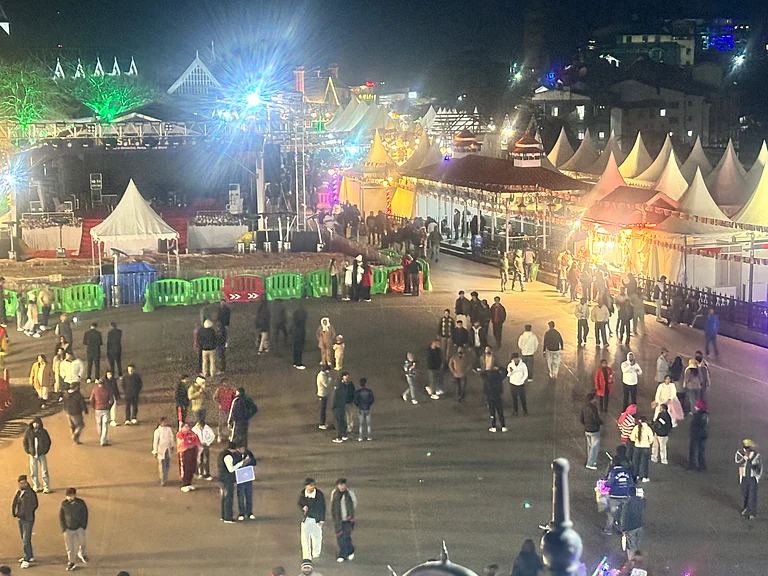The share of stubble burning in Delhi's PM2.5 pollution jumped to 38 per cent on Thursday, which experts said was the reason behind the thick layer of pungent smog over the national capital.
Gufran Beig, founder project director, SAFAR, a forecasting agency under the Ministry of Earth Sciences, said, "The share of stubble burning in Delhi's pollution has increased to around 38 per cent which is quite significant."
Retaliatory accusations
The increase in stubble burning has kicked off a political slugfest, with Union Environment Minister Bhupender Yadav on Wednesday saying that there had been a 19 per cent rise in farm fires over 2021 in Punjab and that the Aam Aadmi Party (AAP) had turned the national capital into a gas chamber.
Delhi Chief Minister Arvind Kejriwal, in turn, blamed the central government for rising incidents of stubble burning in Punjab and said it should "resign" if it cannot control air pollution.
Air quality severe, public health at risk
The air pollution situation is the worst in Noida which falls into the path of emissions being transported from stubble burning, he said. "Gurugram and Lodhi Road areas which do not fall into this path are the least affected," Beig said.
Delhi's air quality slipped back into the "severe" zone Thursday morning amid raging farm fires and stagnant conditions at night. The overall air quality index stood at 419 at 9 am.
"The overall air quality in Delhi will continue to remain in the severe category till Friday morning. There will be slight improvement afterwards. A major relief is likely on Saturday due to predicted improvement in meteorological conditions -- wind speed and direction," Beig said.
An AQI (air quality index) of above 400 is considered "severe" and can affect healthy people and seriously impact those with existing illnesses. According to the Energy Policy Institute at the University of Chicago's (EPIC) Air Quality Life Index (AQLI) released in June, the residents of Delhi stand to lose 10 years of life expectancy due to poor air quality.
Increasing incidents of stubble burning
Punjab had on Wednesday reported 3,634 farm fires, the highest this season so far, though their share in Delhi PM2.5 pollution stood at just 12 per cent due to unfavourable transport-level wind speed.
The number of farm fires stood at 1,842 on Tuesday, 2,131 on Monday, 1,761 on Sunday, 1,898 on Saturday and 2,067 on Friday.
SAFAR said the share of stubble burning in Delhi's PM2.5 pollution was "moderate" at 12 per cent due to unfavourable transport-level wind speed. Transport-level winds blow in the lowest two layers of the atmosphere -- the troposphere and stratosphere -- and carry smoke from farm fires to the national capital region.
Farm fires accounted for 14 per cent of the PM2.5 pollution in the national capital on Tuesday, 22 per cent on Monday, 26 per cent on Sunday and 21 per cent on Saturday, according to the System of Air Quality and Weather Forecasting and Research (SAFAR).
PM2.5 are fine particles that are 2.5 microns or less in diameter and can travel deep into the respiratory tract, reaching the lungs and entering the bloodstream.
November 1-15 crucial time
The Commission for Air Quality Management had last week said the increased incidents of stubble burning in Punjab this year "is a matter of serious concern".
Along with unfavourable meteorological conditions, paddy straw burning in adjoining states is a major reason behind the alarming spike in air pollution levels in the national capital in October and November. Farmers set their fields on fire to quickly clear off the crop residue before cultivating wheat and vegetables.
According to the Indian Agricultural Research Institute (IARI), Punjab reported 71,304 farm fires between September 15 and November 30 last year and 83,002 farm fires in the corresponding period in 2020. Last year, the share of farm fires in Delhi's PM 2.5 pollution peaked to 48 per cent on November 7.
According to an analysis by the Delhi Pollution Control Committee, people in the national capital breathe the worst air between November 1 and November 15 -- the period when stubble burning peaks.
The city records an average PM2.5 concentration of 285 micrograms per cubic metre from November 1 to November 15. PM 2.5 level from 61 to 120 is considered "moderate to poor", 121 to 250 is "very poor", 251 to 350 is "severe" and more than 350 is "severe plus".
(With inputs from PTI)


























